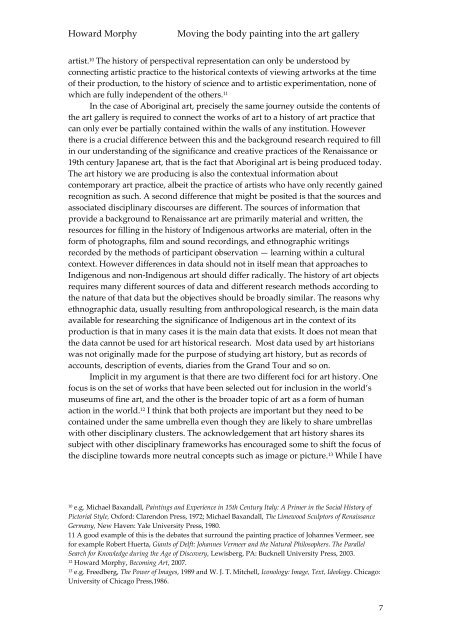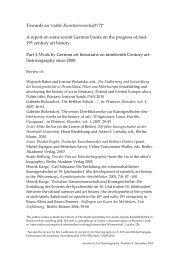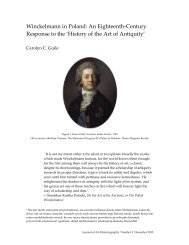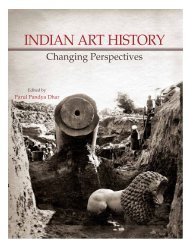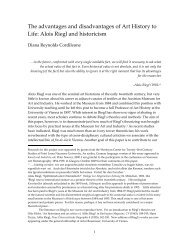Moving the body painting into the art gallery - Journal of Art ...
Moving the body painting into the art gallery - Journal of Art ...
Moving the body painting into the art gallery - Journal of Art ...
Create successful ePaper yourself
Turn your PDF publications into a flip-book with our unique Google optimized e-Paper software.
Howard Morphy <strong>Moving</strong> <strong>the</strong> <strong>body</strong> <strong>painting</strong> <strong>into</strong> <strong>the</strong> <strong>art</strong> <strong>gallery</strong><br />
<strong>art</strong>ist. 10 The history <strong>of</strong> perspectival representation can only be understood by<br />
connecting <strong>art</strong>istic practice to <strong>the</strong> historical contexts <strong>of</strong> viewing <strong>art</strong>works at <strong>the</strong> time<br />
<strong>of</strong> <strong>the</strong>ir production, to <strong>the</strong> history <strong>of</strong> science and to <strong>art</strong>istic experimentation, none <strong>of</strong><br />
which are fully independent <strong>of</strong> <strong>the</strong> o<strong>the</strong>rs. 11<br />
In <strong>the</strong> case <strong>of</strong> Aboriginal <strong>art</strong>, precisely <strong>the</strong> same journey outside <strong>the</strong> contents <strong>of</strong><br />
<strong>the</strong> <strong>art</strong> <strong>gallery</strong> is required to connect <strong>the</strong> works <strong>of</strong> <strong>art</strong> to a history <strong>of</strong> <strong>art</strong> practice that<br />
can only ever be p<strong>art</strong>ially contained within <strong>the</strong> walls <strong>of</strong> any institution. However<br />
<strong>the</strong>re is a crucial difference between this and <strong>the</strong> background research required to fill<br />
in our understanding <strong>of</strong> <strong>the</strong> significance and creative practices <strong>of</strong> <strong>the</strong> Renaissance or<br />
19th century Japanese <strong>art</strong>, that is <strong>the</strong> fact that Aboriginal <strong>art</strong> is being produced today.<br />
The <strong>art</strong> history we are producing is also <strong>the</strong> contextual information about<br />
contemporary <strong>art</strong> practice, albeit <strong>the</strong> practice <strong>of</strong> <strong>art</strong>ists who have only recently gained<br />
recognition as such. A second difference that might be posited is that <strong>the</strong> sources and<br />
associated disciplinary discourses are different. The sources <strong>of</strong> information that<br />
provide a background to Renaissance <strong>art</strong> are primarily material and written, <strong>the</strong><br />
resources for filling in <strong>the</strong> history <strong>of</strong> Indigenous <strong>art</strong>works are material, <strong>of</strong>ten in <strong>the</strong><br />
form <strong>of</strong> photographs, film and sound recordings, and ethnographic writings<br />
recorded by <strong>the</strong> methods <strong>of</strong> p<strong>art</strong>icipant observation — learning within a cultural<br />
context. However differences in data should not in itself mean that approaches to<br />
Indigenous and non-Indigenous <strong>art</strong> should differ radically. The history <strong>of</strong> <strong>art</strong> objects<br />
requires many different sources <strong>of</strong> data and different research methods according to<br />
<strong>the</strong> nature <strong>of</strong> that data but <strong>the</strong> objectives should be broadly similar. The reasons why<br />
ethnographic data, usually resulting from anthropological research, is <strong>the</strong> main data<br />
available for researching <strong>the</strong> significance <strong>of</strong> Indigenous <strong>art</strong> in <strong>the</strong> context <strong>of</strong> its<br />
production is that in many cases it is <strong>the</strong> main data that exists. It does not mean that<br />
<strong>the</strong> data cannot be used for <strong>art</strong> historical research. Most data used by <strong>art</strong> historians<br />
was not originally made for <strong>the</strong> purpose <strong>of</strong> studying <strong>art</strong> history, but as records <strong>of</strong><br />
accounts, description <strong>of</strong> events, diaries from <strong>the</strong> Grand Tour and so on.<br />
Implicit in my argument is that <strong>the</strong>re are two different foci for <strong>art</strong> history. One<br />
focus is on <strong>the</strong> set <strong>of</strong> works that have been selected out for inclusion in <strong>the</strong> world’s<br />
museums <strong>of</strong> fine <strong>art</strong>, and <strong>the</strong> o<strong>the</strong>r is <strong>the</strong> broader topic <strong>of</strong> <strong>art</strong> as a form <strong>of</strong> human<br />
action in <strong>the</strong> world. 12 I think that both projects are important but <strong>the</strong>y need to be<br />
contained under <strong>the</strong> same umbrella even though <strong>the</strong>y are likely to share umbrellas<br />
with o<strong>the</strong>r disciplinary clusters. The acknowledgement that <strong>art</strong> history shares its<br />
subject with o<strong>the</strong>r disciplinary frameworks has encouraged some to shift <strong>the</strong> focus <strong>of</strong><br />
<strong>the</strong> discipline towards more neutral concepts such as image or picture. 13 While I have<br />
10 e.g. Michael Baxandall, Paintings and Experience in 15th Century Italy: A Primer in <strong>the</strong> Social History <strong>of</strong><br />
Pictorial Style, Oxford: Clarendon Press, 1972; Michael Baxandall, The Limewood Sculptors <strong>of</strong> Renaissance<br />
Germany, New Haven: Yale University Press, 1980.<br />
11 A good example <strong>of</strong> this is <strong>the</strong> debates that surround <strong>the</strong> <strong>painting</strong> practice <strong>of</strong> Johannes Vermeer, see<br />
for example Robert Huerta, Giants <strong>of</strong> Delft: Johannes Vermeer and <strong>the</strong> Natural Philosophers. The Parallel<br />
Search for Knowledge during <strong>the</strong> Age <strong>of</strong> Discovery, Lewisberg, PA: Bucknell University Press, 2003.<br />
12 Howard Morphy, Becoming <strong>Art</strong>, 2007.<br />
13 e.g. Freedberg, The Power <strong>of</strong> Images, 1989 and W. J. T. Mitchell, Iconology: Image, Text, Ideology. Chicago:<br />
University <strong>of</strong> Chicago Press,1986.<br />
7


